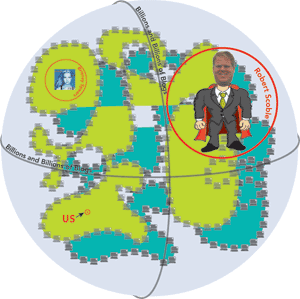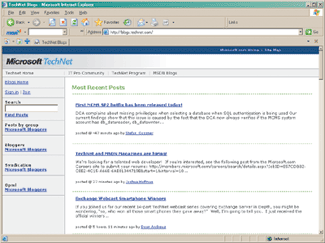Blog TalesBlogging Is Only the Beginning
Betsy Aoki
A while back, a TechNet editor asked me to convert my stunningly successful, teeth-gleaming, world-wide TechEd presentation (well, Europe and Australia) about Microsoft employee blogging into an article for TechNet Magazine. He felt that since I was the Microsoft "Blog Queen," I might have something to contribute.
The poor fellow wrote: "In the past, this column has essentially just contained a reprint of a useful technical blog entry, but I wonder if in one of our upcoming issues, it might be interesting to talk about how Microsoft does blogging—our place in the blogosphere."
Unfortunately for us and everyone else who blogs, our place in the blogosphere is "accurately" depicted in Figure 1. It gives me goose bumps just thinking about it.

Figure 1** The Worldwide Blogosphere **
Microsoft employees have blogged far longer than Microsoft the company has sponsored a resting place for them, with Joshua Allen being among the first, if not the first. Near as I can figure out, the first Microsoft employee to have his blog hosted by the company was the Mighty Don Box, who originally created his home-grown Spoutlet application on www.gotdotnet.com in the summer of 2002. A candid blog, refreshingly named.
After that, gotdotnet took up the challenge of hosting more employees on a "Microsoft spare time" bit of software by Chris Anderson called BlogX. This meant yours truly hand-copying the application bits to a server, signing up someone with a password, and then resetting IIS so the blog would run. It was fine when people hadn’t heard about blogs, but we rapidly found BlogX worked better as a one-blogger-on-the-site engine than a scalable many-bloggers-on-the-site platform.
Thus, during the 2003 Professional Developers Conference, we got too big for our blogging britches. The 200 or so employee bloggers on BlogX posted up a storm, nearly doubling gotdotnet traffic and making its servers beg for mercy. So in January of 2004 we moved them to the .Text platform hosted by www.asp.net (another community Web site run by a Microsoft team). By the end of that year, we had over 1,000 employee bloggers, each gallantly serving customer needs through a variety of superb blog posts.
On April 1, 2005 (always auspicious), we launched blogs.technet.com with about 80 bloggers ready to hold forth on what IT pros want to know, and to hear what IT pros want to tell us (see Figure 2). This site has grown steadily in traffic and the number of bloggers has more than doubled.

Figure 2** TechNet Blogs **
Some Microsoft employees, like Chris Brumme, blog only when certain arcane conditions are correct, but are so darn useful that each post is heralded with much rejoicing in the technology hinterlands. Others, like Raymond Chen, are so prolific they have developed internal tools—what I fondly call Raymond’s "blog gun"—that automatically fire posts out at specific times of the day. One superstar of the TechNet blogs is "You had me at EHLO," the Exchange team’s mega-blog. And as you might expect, the Microsoft Security Response Center blog is very close behind in terms of loyalty and traffic. Wandering around the TechNet Web site you will see a number of blogs linked to and referenced, connecting the details of many different developer and IT pro topics.
For those of you who want to try this blogging thing at home, Telligent Systems makes a version of Community Server available at www.communityserver.org. That’s the software currently powering blogs.msdn.com and blogs.technet.com, and you can look at the source code as well as get involved in the Community Server forums if you have questions about installation, configuration, and so on.
The part you can’t download and try at home is the delivery mechanism that Microsoft.com uses to generate lists of links to blog posts and blog home pages. Known as Smart Components, this system represents proprietary code we don’t give out, but we are happy to share the concepts of how to do it.
It’s hard to sum up in a highly irreverent column, but basically we suck the RSS down, throw it around, attribute it thanks to righteous input from employees about their own blogs, and play loud, thumping techno music. Then, with furious dance moves across the servers and big, blinking lights, we spit XML out through a Web service and display it through local controls on the MSDN® Web site (see Figure 3). Of course, we completely scrub out the bloggers’ stray HTML markup in the posts. The post may then look a bit wacky in content, but this scrub prevents any incomplete HTML markup from mangling actual MSDN pages rendering the content.

Figure 3** Smart Components Architecture **
However, in the way of all things that looked cool at Microsoft for about 15 minutes, Smart Components are on their way out, and an entirely new system is being built to replace them. Code-named "Helios," then code-named "Athens," it may go through several more arcane classical references before it ships. But the new system promises to deliver better, fresher content on more platforms in more places. Gotdotnet itself may change to become more Athenian.
As I said—we suck RSS down, we snazzy it up, we toss it out, we share it with you. You boogie it down, you swirl it back around... that’s called community. The blogging is only the beginning.
Betsy Aoki is a community program manager for Microsoft. Her gentle neuroses are avidly expressed in her e-mails, blog posts, and, at times, Visual Basic .NET.
© 2008 Microsoft Corporation and CMP Media, LLC. All rights reserved; reproduction in part or in whole without permission is prohibited.